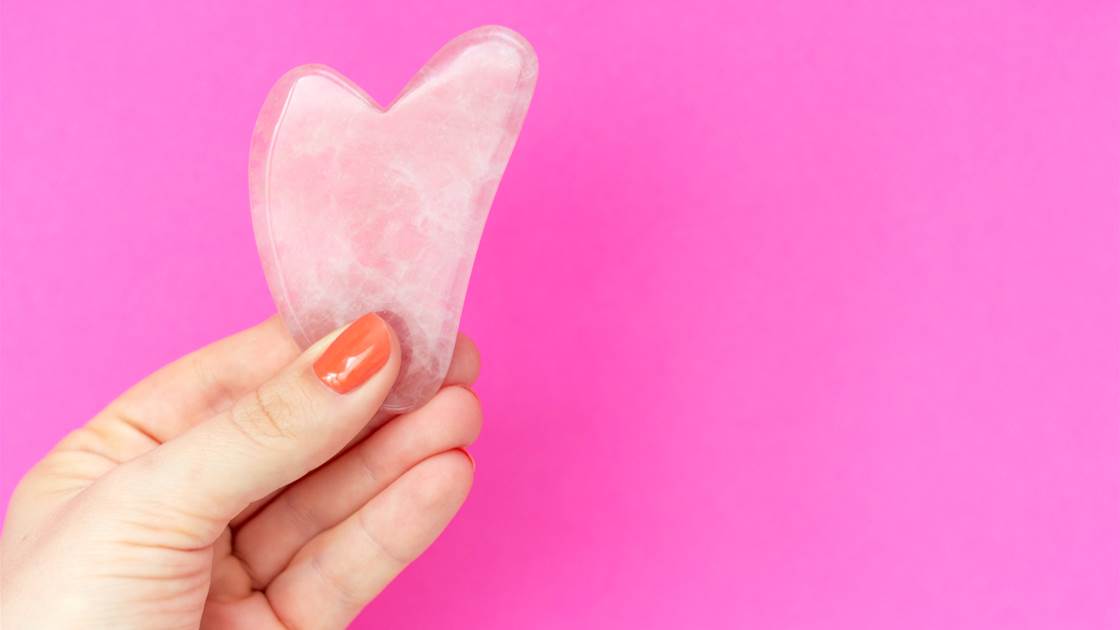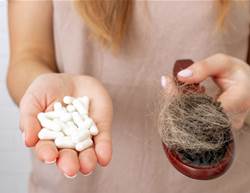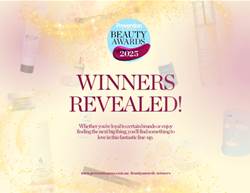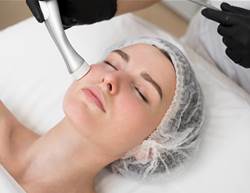Beauty news, wonder ingredients and trends can go viral at the speed of light, leaving many of us scrambling to catch up the latest elixir of youth. But which ones live up to the hype? We put five current big-hitters under the virtual microscope and asked a panel of experts for their take.
Gua Sha Massage Stones
These smooth, flat, oddly shaped pebbles (often made out of ‘healing’ gemstones) are said to de-puff, reshape and ‘de-age’ the skin.
ABSOLUTELY “Done correctly and consistently – and I encourage people to watch videos – the Gua Sha technique will help reduce the appearance of fine lines and wrinkles,” says celebrity facialist and skincare expert Su-Man Hsu. When used with long, outward strokes and plenty of face oil to prevent dragging, the pressure “releases tension, enhances circulation and nourishes the fascia – the sheets of connective tissue that enclose facial muscles,” she says. “It de-puffs and gives an instant glow, but in the long run will boost collagen.” And which ‘magic crystal’ is best? “That’s all nonsense. I favour ceramic stones myself, for their thicker, smoother texture.”
NOT SO SURE “When done right regularly, facial massage has its perks,” says Debbie Thomas, a clinical facialist and laser specialist. “A Gua Sha massage will help relax skin and give it a nice glow for a few days, and the stone can help in that it makes massage easier for some people. However, if you’re looking for long-term gain, there is no comparison with treatments such as lasers and professional peels, which change your skin by correcting imperfections and triggering cell renewal.”
Our verdict Any regular facial massage that works on the underlying tissues, without damaging elastin fibres by tugging at the skin, will boost skin health over time. But don’t expect a dramatic transformation…and certainly not from expensive gemstones.
Salt by Hendrix Rose Quartz Gua Sha Face Sculpting Tool, $29.95
Bakuchiol
This plant extract is billed by some as ‘natural retinol’, capable of diminishing fine lines, wrinkles and pigmentation without irritation.
YES “Bakuchiol has been used in Ayurvedic medicine forever,” says Balance Me skincare co-founder Rebecca Hopkins. “When used at the optimum level [said to be between 0.5 and 2 per cent], this plant-derived alternative to retinol has been found to enhance collagen production, provide antioxidant protection, calm inflammation and reduce photo damage. All without the peeling, dryness and sensitivity associated with retinol.”
YES, BUT... “The ‘less aggressive retinol substitute’ reference comes from one study that said bakuchiol showed similar results to retinol and everyone picked up on it, despite the fact they work in different ways,” explains Paula Begoun from Paula’s Choice. “Retinol stops the production of damaged cells, while bakuchiol is an antioxidant that calms and protects, allowing skin to function better. That said, bakuchiol is still a great addition to your skincare. It supports the function of other ingredients, including retinol. Also, because it’s a phytoestrogen, it’s helpful during menopause to counter the drop in hydration and collagen production caused by falling oestrogen levels.”
Our verdict Bakuchiol is your anti-ageing (and non-irritating) friend, but, as with many ingredients, we like ours with complementary actives.
Trilogy Bakuchiol+ Booster Treatment, $39.95
Blue-light Protection
Blue light, part of the sun’s spectrum, is known to damage skin. Smartphones and other gadgets emit it, too, so should we slather on blue light-protective skincare indoors?
GOOD IDEA “Blue light, or high-energy visible light (HEVL), is the electromagnetic radiation from electronic screens – mobiles, laptops and TVs,” says Rowan Hall-Farrise, head of global education for QMS Medicosmetics. “Increased exposure may cause slacker skin, brown spots and other signs of ageing.” She advises wearing a sunscreen with mineral filters (zinc oxide and titanium dioxide) indoors, as “initial studies indicate this could offer protection”. Hall-Farrise is also a fan of seeking out antioxidant ingredients. “These mitigate the inflammation caused by environmental stressors, of which blue light is one.”
IT’S COMPLICATED “It’s a marketing myth,” says dermatologist Dr Anjali Mahto. “Based on current research, the small amount of HEVL emitted by devices is unlikely to damage skin. But HEVL from daylight is a concern, causing cell damage and – disproportionally in darker skin tones – hyperpigmentation. So HEVL protection is actually more worthwhile outside. The problem is that the only thing that blocks HEVL are iron oxides. These mineral powders (different from mineral UV filters such as zinc oxide and titanium dioxide) have a pale tint, which can leave a cast on dark skin, so are used rarely. They can be found in a few sunscreens, some formulated to avoid this. Antioxidant protection also helps, in that it counters the free radical damage wreaked on your cells by blue, UV and infrared light. I recommend wearing a vitamin C serum (look for 10 to 15 per cent L-ascorbic acid) under your sunscreen. It’s one of the best studied antioxidants in skincare.”
Our verdict Your smartphone might not be ageing you, but the HEVL in sunlight reconfirms the need for that most essential of anti-ageing potions: a high-SPF, broad-spectrum sunscreen. Look for one with iron oxide, if you can, ideally worn with an antioxidant serum underneath.
Colorescience Sunforgettable Total Protection Brush-On Shield SPF 30, $99
La Roche-Posay Pure Vitamin C10 Serum, $71.95
CBD
The calming and balancing properties of CBD (cannabidiol – a non-hallucinogenic molecule extracted from the hemp plant) may be proven, but in Australia, it’s still considered a Schedule 4 drug, only available to certain patients with a prescription and certainly not yet seen on beauty counters here. But numerous brands overseas have been touting the skin-soothing effects of this wonder ingredient and consumers appear to have been benefiting from CBD’s charms. Either way, it’s a serious beauty buzzword that deserves further exploration.
YES “Studies show that CBD has anti-inflammatory effects on the skin in the same way that, for example, oat extracts are soothing,” says Kloris CBD skincare founder Kim Smith. “But CBD also has other benefits. It’s a powerful antioxidant, and because it works with the skin’s CB2 receptors, which are linked to the system that, among other things, regulates immune function, it encourages balance and optimal functioning of the skin and its barrier. This means it could be helpful with conditions such as acne, where sebaceous glands need regulating.” While clinical studies on topical CBD have been sparse due to the long prohibition of cannabis, Smith says that “they’re from well-respected sources (namely, the NCBI – the US National Center For Biotechnology Information), so they’re very much valid. While we wait for more trials to take place (and for it to become legal in Australia), the real-life anecdotal evidence speaks for itself.”
A HARD NO “Okay, topical CBD may display anti-inflammatory properties, since cannabinoid receptors in the skin are part of the endocannabinoid system, which is responsible for pain sensation,” says pharmacist Shabir Daya from victoriahealth.com. “But there are more potent and effective anti-inflammatories that also work with these receptors, such as turmeric and ginger. As these natural options are often combined with CBD, it’s hard to know how well CBD works on its own. Overall, the clinical evidence on most of the purported benefits of CBD is limited and I’m yet to see anything that proves antioxidant protection and sebum regulation.”
Our verdict Anti-inflammatory properties are always welcome in our skincare, but, as yet, the jury is out over whether CBD is better than other lauded (and often cheaper) anti-inflammatories, such as curcumin (turmeric’s main active ingredient) and oat extracts.
Cannabella Renewal Serum, from $34
Probiotics
Topical application of healthy bacteria is credited with rebalancing the skin’s protective acid mantle (or microbiome), restoring calm and optimal functioning.
UNLIKELY “I don’t see how this can work,” says Dr Mahto. “Most probiotic skincare doesn’t contain live bacteria but lysates: essentially dead bacterial cell walls. There’s little evidence this provides any benefit. Secondly, much of the bacteria used in skincare is based on what we know of the gut microbiome, but it’s a leap of faith to assume the bacteria that improves your gut could also benefit your skin. Thirdly, each skin microbiome is highly individual, consisting of many more than the one or two strains of bacteria routinely used in skincare, and comprising not only bacteria, but also yeast, fungus, mould and viruses. It’s unlikely we can replicate this with limited emerging science.”
ON THE OTHER HAND… “The point of probiotic skincare is not to ‘repopulate’ the microbiome with live bacteria,” says pharmacist and Gallinée founder Marie Drago. “The dead bits of bacteria, which are recognised by skin receptors, show impressive soothing and moisturising properties. They’re also a food source for resident ‘good’ bacteria and proven to positively stimulate any skin microbiome.” It’s the lysate pieces that make a change in the skin, not the live bacteria, which wouldn’t survive in the jar, says Terri Vinson, founder of Synergie Skin and author of Skinformation. “One of my favourite ingredients is the lysate of Bifidobacterium. This active ingredient improves the immune system of the skin and significantly reduces skin sensitivity, irritation, redness, dryness and fine lines. This probiotic ingredient is excellent at making the skin barrier stronger and more resilient, and addressing inflammation, which is the root cause of all negative skin conditions.”
Our verdict So far, we’ve found that some probiotic skincare has had a noticeably calming effect on our skin – and we’ll be keeping an open mind as the science improves.










